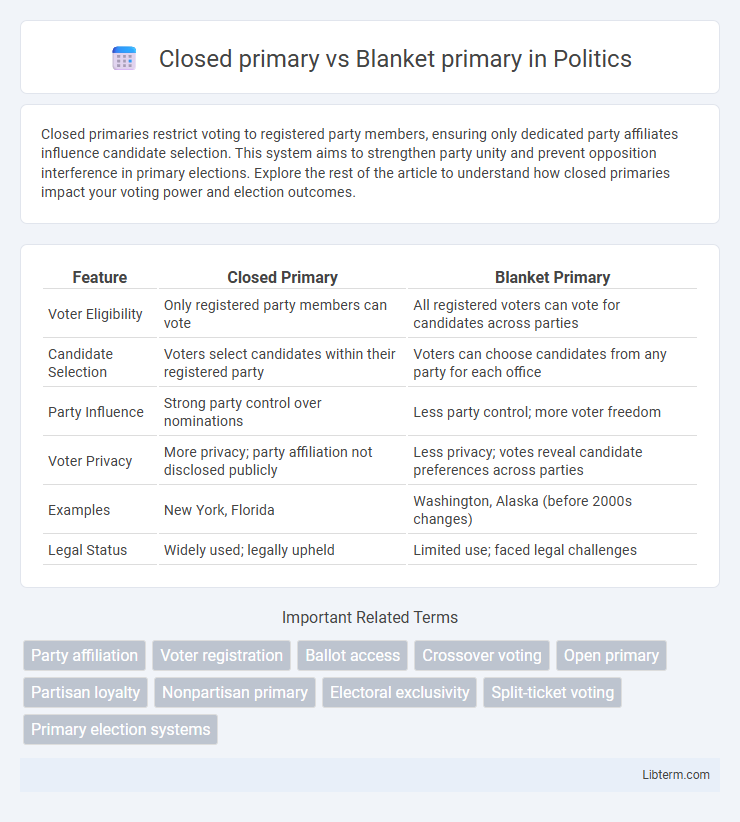Closed primaries restrict voting to registered party members, ensuring only dedicated party affiliates influence candidate selection. This system aims to strengthen party unity and prevent opposition interference in primary elections. Explore the rest of the article to understand how closed primaries impact your voting power and election outcomes.
Table of Comparison
| Feature | Closed Primary | Blanket Primary |
|---|---|---|
| Voter Eligibility | Only registered party members can vote | All registered voters can vote for candidates across parties |
| Candidate Selection | Voters select candidates within their registered party | Voters can choose candidates from any party for each office |
| Party Influence | Strong party control over nominations | Less party control; more voter freedom |
| Voter Privacy | More privacy; party affiliation not disclosed publicly | Less privacy; votes reveal candidate preferences across parties |
| Examples | New York, Florida | Washington, Alaska (before 2000s changes) |
| Legal Status | Widely used; legally upheld | Limited use; faced legal challenges |
Definition of Closed Primary
A closed primary is an election in which only registered party members can vote to select their party's candidates, ensuring that the nomination process remains within the party's control. Voters must declare their party affiliation before the primary, preventing crossover voting from members of other parties. This system contrasts with a blanket primary, where all candidates from all parties appear on a single ballot, and voters can choose freely among them regardless of party affiliation.
Definition of Blanket Primary
A blanket primary is a type of primary election where all candidates from all parties are listed on the same ballot, allowing voters to choose one candidate for each office regardless of party affiliation. Unlike a closed primary, where only registered party members can participate in their party's primary, the blanket primary enables voters to cross party lines and select candidates across different parties in a single election. This system promotes broader voter choice and can influence party dynamics by allowing more flexible participation.
Key Differences Between Closed and Blanket Primaries
Closed primaries restrict voting to registered party members, ensuring candidates are chosen by dedicated party supporters, whereas blanket primaries allow all voters to select candidates from any party on a single ballot, promoting broader voter participation. In closed primaries, party affiliation must be declared beforehand, limiting crossover voting, while blanket primaries enable voters to mix choices across different party candidates in one election. This fundamental difference impacts candidate selection dynamics, party control over nominations, and voter influence on election outcomes.
Eligibility Rules: Who Can Vote?
Closed primary elections restrict voting to registered party members, ensuring only those officially affiliated with a political party can participate in selecting that party's candidates. Blanket primary elections allow all registered voters to cast ballots for any candidate across party lines, regardless of their own party registration. Voter eligibility in closed primaries guarantees party loyalty in candidate selection, while blanket primaries offer a more open and inclusive approach to voter participation.
Impact on Voter Turnout
Closed primaries tend to lower voter turnout since only registered party members can participate, restricting independent or unaffiliated voters from influencing candidate selection. Blanket primaries increase voter participation by allowing all registered voters to select candidates from any party, promoting a more inclusive electoral process. This openness often leads to higher engagement and turnout, especially among independent voters who might otherwise be excluded.
Influence on Party Loyalty
Closed primaries strengthen party loyalty by restricting voting to registered party members, which encourages candidates to appeal specifically to core party values and base voters. Blanket primaries dilute party loyalty because voters can choose candidates from any party, often leading to cross-party voting and less distinct party platforms. This system can blur ideological lines and reduce the emphasis on strong party allegiance during candidate selection.
Effects on Election Outcomes
Closed primaries limit voting to registered party members, often resulting in the nomination of candidates who strongly align with party ideologies, thereby influencing election outcomes by reinforcing party bases. Blanket primaries allow voters to select candidates across party lines, increasing the likelihood of moderate candidates who appeal to a broader electorate, which can shift general elections toward centrism. These differences significantly impact candidate selection, voter turnout, and the overall competitiveness of elections.
Legal Status and Historical Use in the U.S.
Closed primaries require voters to register with a specific political party before election day, ensuring only party members participate in selecting candidates, a system legally upheld since the early 20th century to promote party integrity. Blanket primaries, allowing voters to choose candidates from any party in a single primary, faced legal challenges culminating in the 2000 U.S. Supreme Court ruling in California Democratic Party v. Jones, which deemed them unconstitutional for infringing on party association rights. Historically, closed primaries have dominated much of the U.S. for maintaining party control, while blanket primaries represented reform efforts to increase voter flexibility before their legal invalidation.
Advantages and Disadvantages of Closed Primaries
Closed primaries limit voting to registered party members, enhancing party unity and reducing the risk of strategic voting by opposition members, which helps maintain ideological consistency in candidate selection. However, this exclusivity can discourage independent or unaffiliated voters from participating, potentially lowering overall voter turnout and limiting broader democratic engagement. The closed primary system also risks alienating moderate voters who may feel constrained by strict party boundaries, affecting the general election dynamics.
Advantages and Disadvantages of Blanket Primaries
Blanket primaries allow all voters to choose candidates from any party for each office, increasing voter freedom and encouraging crossover voting, which can lead to more moderate candidates. However, this system may dilute party ideology and create confusion among voters due to the mixing of candidates across party lines. The potential for strategic voting also raises concerns about undermining party cohesion and weakening traditional party influence.
Closed primary Infographic

 libterm.com
libterm.com